★★½
“Mexican lady mob boss runs out of steam, if not of costumes.”
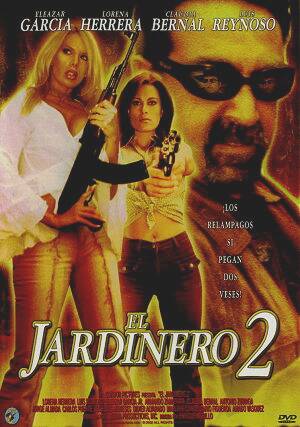 Not seen part one? Never fear! Thanks to the magic of flashback, we see that Lilia Gallardo (Herrera) killed her husband, shot his son Pablo, and has now taken over their drug business. This is to the dismay of his men who, with typically Mexican machismo, feel a woman is unsuited to the role, and also Pablo, who is not dead, but is now recuperating on a nearby ranch, waiting his opportunity for revenge.
Not seen part one? Never fear! Thanks to the magic of flashback, we see that Lilia Gallardo (Herrera) killed her husband, shot his son Pablo, and has now taken over their drug business. This is to the dismay of his men who, with typically Mexican machismo, feel a woman is unsuited to the role, and also Pablo, who is not dead, but is now recuperating on a nearby ranch, waiting his opportunity for revenge.
This starts in fine, trashy style. Lilia is bleached blonde, collagen-lipped, and has wildly inappropriate outfits from Sluts R Us. Her approach to treacherous henchmen is fully hands-on, not to mention fully-automatic, and transcends the lack of English subs on the DVD. The sexist bitching lends an authentic edge to the idea of a woman operating in a man’s world – and if you’re wondering, credit to Chris who translated for me, while rolling her eyes at Lilia’s clothes. Particularly the three-inch wide miniskirt…
Unfortunately, it gets bogged down and talky as things progress; the heroine recruits an assistant of somewhat alcoholic bent, and also gets involved with a South American Mr. Big. Meanwhile, Pablo is growing fond of the rancher’s daughter (Bernal), but she witnesses a shootout, and is captured by Lilia’s men. It’s all rather more plot than I wanted to see, and the hoped-for face-off between Bernal and Herrera fizzles, despite what seems like significant setting-up. You know it’s all heading towards a Pablo-Lilia showdown, and it’s giving nothing away to say that’s exactly where it ends, though even this comes off as something of a damp squib. Still, think we’ll be keeping an eye open for its predecessor.
Dir: Enrique Murillo
Star: Lorena Herrera, Eleazar Garcia, Claudia Bernal, Luis Reynoso





 This bleak, nihilist view of 1980’s Hong Kong ran into severe trouble with local censors, for its depiction of the colony as populated solely by violent brutes. Leading these is Pearl (Lin), a teenage girl who redefines the term “troubled”, and whose brother (Lo) is a cop with a short fuse. She witnesses a hit-and-run accident and browbeats the three kids involved into joining her in a relentlessly-escalating series of violent escapades. When they find themselves in possession of 800 million yen belonging to gun-smugglers, you just
This bleak, nihilist view of 1980’s Hong Kong ran into severe trouble with local censors, for its depiction of the colony as populated solely by violent brutes. Leading these is Pearl (Lin), a teenage girl who redefines the term “troubled”, and whose brother (Lo) is a cop with a short fuse. She witnesses a hit-and-run accident and browbeats the three kids involved into joining her in a relentlessly-escalating series of violent escapades. When they find themselves in possession of 800 million yen belonging to gun-smugglers, you just 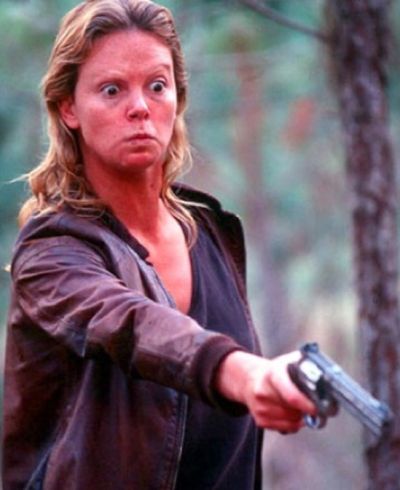
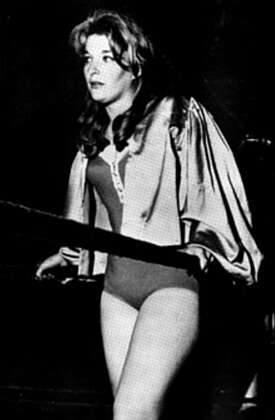 Despite the title, and the fact that Vivian Vachon is the most featured wrestler, the portion of this film which has much to do with women’s wrestling is actually rather small. It’s more a general overview of wrestling and it’s fans, during a strangely innocent era (the early 1970’s), before Vince McMahon dominated, when it still worked to give the illusion of a genuine sport.
Despite the title, and the fact that Vivian Vachon is the most featured wrestler, the portion of this film which has much to do with women’s wrestling is actually rather small. It’s more a general overview of wrestling and it’s fans, during a strangely innocent era (the early 1970’s), before Vince McMahon dominated, when it still worked to give the illusion of a genuine sport.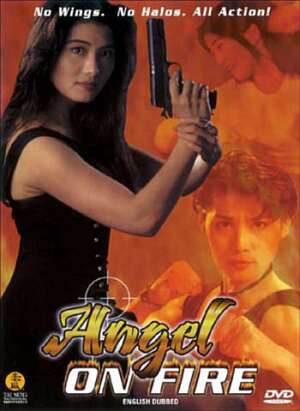 Supermodel-thief Mimi (Melanie Marquez) steals an artifact from a Chinese temple, then heads to the Philippines, via Hong Kong. HK and Chinese cops (Khan & Yeung) are on her tail, as is former partner Ko. This is, frankly, a mess. Yeung apparently does no detective work; Khan goes on a date to an illegal street fight; they’re supposedly partners, but only share one scene; and what
Supermodel-thief Mimi (Melanie Marquez) steals an artifact from a Chinese temple, then heads to the Philippines, via Hong Kong. HK and Chinese cops (Khan & Yeung) are on her tail, as is former partner Ko. This is, frankly, a mess. Yeung apparently does no detective work; Khan goes on a date to an illegal street fight; they’re supposedly partners, but only share one scene; and what  This is one of those Hong Kong movies which seems to believe that if they cram in enough complications and characters, you’ll overlook the deficiencies. They’re kinda right: if you can let go (I did, Chris couldn’t), you will enjoy this a whole lot more, though here, it’d take five times as much plot to make you ignore the truly woeful titular bird. There would seem to have been confusion in the prop department over whether the request for a “giant crane” meant a bird or a piece of construction equipment: it looks as if they split the difference, building something with feathers, which remains (painfully) obviously mechanical.
This is one of those Hong Kong movies which seems to believe that if they cram in enough complications and characters, you’ll overlook the deficiencies. They’re kinda right: if you can let go (I did, Chris couldn’t), you will enjoy this a whole lot more, though here, it’d take five times as much plot to make you ignore the truly woeful titular bird. There would seem to have been confusion in the prop department over whether the request for a “giant crane” meant a bird or a piece of construction equipment: it looks as if they split the difference, building something with feathers, which remains (painfully) obviously mechanical. At first, this isn’t much of anything, least of all an action heroine movie. Cop Simon Yam investigates a customs officer (Shou) who is smuggling guns; it’s pretty ho-hum until an innocent underling is killed after finding evidence of the crimes. When his sister Moon (Lee) and her husband (Lui) get involved, this swiftly leads to the one scene in this film that
At first, this isn’t much of anything, least of all an action heroine movie. Cop Simon Yam investigates a customs officer (Shou) who is smuggling guns; it’s pretty ho-hum until an innocent underling is killed after finding evidence of the crimes. When his sister Moon (Lee) and her husband (Lui) get involved, this swiftly leads to the one scene in this film that 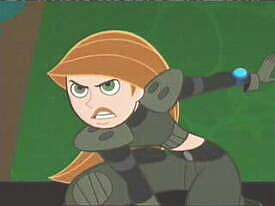
 “I’m working with a man named Monkey Fist. My evil career is
“I’m working with a man named Monkey Fist. My evil career is 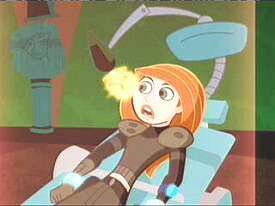 It does remain a Disney show, hence the irritating musical interludes and, while the action is fast and furious, no-one ever gets hurt – though the sequence where a naked mole-rat comes out of a kid’s trousers is frankly freaky. But assisted by a stellar supporting cast (Elliott Gould, Michael Dorn, Dakota Fanning, Michael Clarke Duncan, Vivica A. Fox and – slightly less stellar – Freddie Prinze Jr.), this is a great parody of the whole genre: as one character says, “Time travel – it’s a cornucopia of disturbing concepts.” The tongue-in-cheek self-awareness is a delight, both heroes and villains having a refreshingly world-weary attitude, cheerfully admitting the paradoxes inherent in the story. Even an evil, golfing, kilt-wearing Scot comes over as endearing rather than insulting – Mike Myers, please note. The expected fluff blends with some surprisingly dark moments, such as the “Re-education Center” which seems right out of 1984. This is what the Tomb Raider movies
It does remain a Disney show, hence the irritating musical interludes and, while the action is fast and furious, no-one ever gets hurt – though the sequence where a naked mole-rat comes out of a kid’s trousers is frankly freaky. But assisted by a stellar supporting cast (Elliott Gould, Michael Dorn, Dakota Fanning, Michael Clarke Duncan, Vivica A. Fox and – slightly less stellar – Freddie Prinze Jr.), this is a great parody of the whole genre: as one character says, “Time travel – it’s a cornucopia of disturbing concepts.” The tongue-in-cheek self-awareness is a delight, both heroes and villains having a refreshingly world-weary attitude, cheerfully admitting the paradoxes inherent in the story. Even an evil, golfing, kilt-wearing Scot comes over as endearing rather than insulting – Mike Myers, please note. The expected fluff blends with some surprisingly dark moments, such as the “Re-education Center” which seems right out of 1984. This is what the Tomb Raider movies 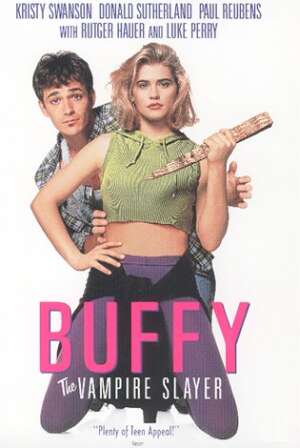 Buffy may be the only successful TV series based upon a failed film. A critical and commercial flop, creator Joss Whedon just wouldn’t let it lie, and finally got the mix of drama, horror, comedy and action he wanted in the show. The movie is a different matter, and has not aged well. The SoCal culture now seems incredibly dated, and Swanson takes too long to become the sympathetic heroine essential to the film. It also has no idea what to
Buffy may be the only successful TV series based upon a failed film. A critical and commercial flop, creator Joss Whedon just wouldn’t let it lie, and finally got the mix of drama, horror, comedy and action he wanted in the show. The movie is a different matter, and has not aged well. The SoCal culture now seems incredibly dated, and Swanson takes too long to become the sympathetic heroine essential to the film. It also has no idea what to  Even given that this was shot in 6 days for $5,000, it sucks on every conceivable level. Scenes are twice as long as necessary, or totally superfluous. The script has little of interest. And since there’s absolutely no sign of talent whatsoever, I have to presume the director slept with his leading lady. Hope she was better in bed than on screen. Rachel and Jane execute drug deals for their boss – emphasis on “execute”, since they get both the cash and your drugs. Jane’s qualms get worse when Rachel is shot dead, and she leaves the organization, until an FBI agent forces her to return, in order to kill her employer. She also gets frequent visits from the ghost of her dead friend.
Even given that this was shot in 6 days for $5,000, it sucks on every conceivable level. Scenes are twice as long as necessary, or totally superfluous. The script has little of interest. And since there’s absolutely no sign of talent whatsoever, I have to presume the director slept with his leading lady. Hope she was better in bed than on screen. Rachel and Jane execute drug deals for their boss – emphasis on “execute”, since they get both the cash and your drugs. Jane’s qualms get worse when Rachel is shot dead, and she leaves the organization, until an FBI agent forces her to return, in order to kill her employer. She also gets frequent visits from the ghost of her dead friend.